The last German raider, or the Battle of dry cargo
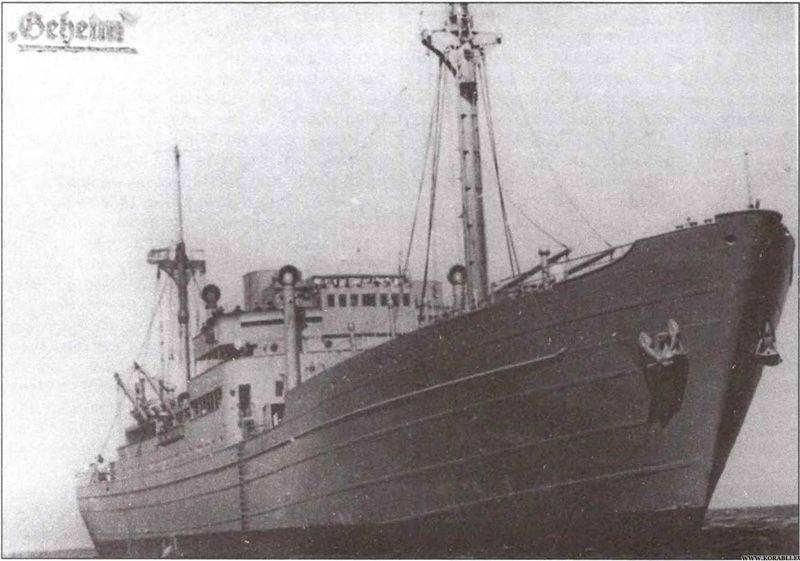
Recorded in corsairs
Since the beginning of World War II, the German command still had high hopes for auxiliary cruisers. Admirals, like generals, always prepare for past wars. Successful campaigns of “Mowe”, the odyssey of “Wolf”, the dramatic epic of “Zeadler” were still too fresh in the memory. Then there were many living witnesses of these martial affairs. The German command reasonably believed that with the help of cruisers-raiders converted from merchant ships, it was, in fact, inexpensive weapons, - you can bring significant chaos and confusion on the huge allied communications, distract the significant forces of the enemy Navy to search and patrol. Therefore, in the pre-war plans, the kriegsmarine was given a significant place for the actions of the raiders against the enemy transport arteries. But, it would seem, a lot of analogies that resonate with the previous war, upon closer examination, turned out to be only external in comparison with the current war. Broad technician stepped forward, radio engineering - communication, search and detection tools improved by an order of magnitude. A completely new format for maritime operations was given by spreading wings for 20 interwar years. aviation.
Nevertheless, with the beginning of the Second World War, the German command sent to the ocean, along with a few while ocean submarines and surface forces. Initially, these were special-built warships, but after the death of the "Count Spee" and especially the "Bismarck" similar ventures were recognized as dangerous and expensive adventures. And the struggle for communications completely passed to the “steel sharks” of Admiral Dönitz and auxiliary cruisers.
Stories German raiders are picturesque and dramatic. They abound in numerous bright fighting episodes. At the beginning of the war, pirate luck often winked at them. However, the Allies made titanic efforts to turn the Atlantic, if not into an Anglo-American lake, then at least into a pocket creek. The means, forces and resources left to fight for communications were simply colossal. In the summer of 1942, despite the seemingly impressive successes of German sailors, especially submariners, this strategy began to bring its first, barely noticeable results. The number of regions in the ocean, where German raiders and supply vessels could feel more or less calm, was inexorably reduced. The breakthrough of German ships into the Atlantic was becoming more and more problematic. The star of the corsairs of the 20th century was drooping. It was in such conditions that the vessel “23” was preparing to sail, which became known as the auxiliary cruiser “Stir” (Stier).
The ship was built in the 1936 year on the Vervi Germanaverft in Kiel and received the name "Cairo". It was a standard ship with a displacement of 11000 tons, equipped with one seven-cylinder diesel engine. Before the war, it made regular commercial cargo flights on behalf of Deutsche Levant Line as a banana carrier. After the start of World War II, “Cairo”, like many other civilian vessels, was requisitioned for the needs of the crigsmarine. Initially, he was converted into a minelayer to participate in the Sea Lion operation that had not taken place. After the initial success of the German raiders on the communications of the allies, the German command decided to increase pressure and increase the number of auxiliary cruisers operating in the ocean. Since the spring of 1941, the ship landed at the wall of the shipyard in the German-occupied Rotterdam. Throughout the summer and autumn, intensive work was being carried out on conversion to the auxiliary cruiser. On November 9, the former cargo ship was enlisted in a kriegsmarine called "Stir" and began to prepare for the march. The ship received standard for the German raiders of the Second World War weapons - 6 × 150-mm guns. Anti-aircraft weapons consisted of 1 × 37-mm guns and 2 × 20-mm machines. "Stir" also carried two torpedo tubes. The nomenclature of weapons included a seaplane for reconnaissance. The commander of the 330 crew was the man who was appointed captain of tour hor Horst Gerlach.
The crew spent the whole winter and early spring of 1942, in preparation for the march. The raider received a huge amount of various means of supply necessary for autonomous navigation. After relevant work, the estimated cruising range of the economic course was supposed to reach 50 thousand tons. By May 1942, all the pre-delivery work was finally completed.
Breakthrough
By the time the Shtira was planned to leave, the situation in the English Channel was such that the Germans had to conduct a whole military operation to successfully break through the raider from the dangerous narrowness of the English channel. Since the breakthrough of the Scharnhorst, Gneisenau and Prince Eugen from Brest (Operation Cerberus, February 1942), much has changed.
In the afternoon of May 12, the Stir, disguised as an auxiliary vessel, the Shperrbrecher 171, left Rotterdam under an escort of four destroyers (Condor, Falke, Zeadler, and Iltis). After leaving the mouth of the river Meuse, 16 minesweepers joined the convoy, who were ahead of the raider and the destroyers. German intelligence reported on the possible presence of English torpedo boats in the strait. By nightfall, the German compound entered the Dover Strait. Shortly before three o'clock, the convoy came under fire from an English 14-inch battery, but to no avail. While the Germans were maneuvering, trying to get out of the zone of destruction of coastal guns, the British boatmen, who managed to get into the attack from the friendly shore, crept almost unnoticed. In a fast-moving battle, the Iltis and the Seadler were sunk. The British did not count the torpedo boat MTK-220.
On May 13, "Shtir" arrived in Boulogne, where he replenished ammunition (the raider generously used lighting shells and small-caliber artillery in a night battle). Then the ship moved to Le Havre to get from there to the mouth of the Gironde on May 19. Here the raider for the last time accepted the means of supply and to the eyeballs filled the fuel Tanks.
From here, Horst Gerlach led his ship south. It was the last successful breakthrough of the German raider into the Atlantic in World War II.
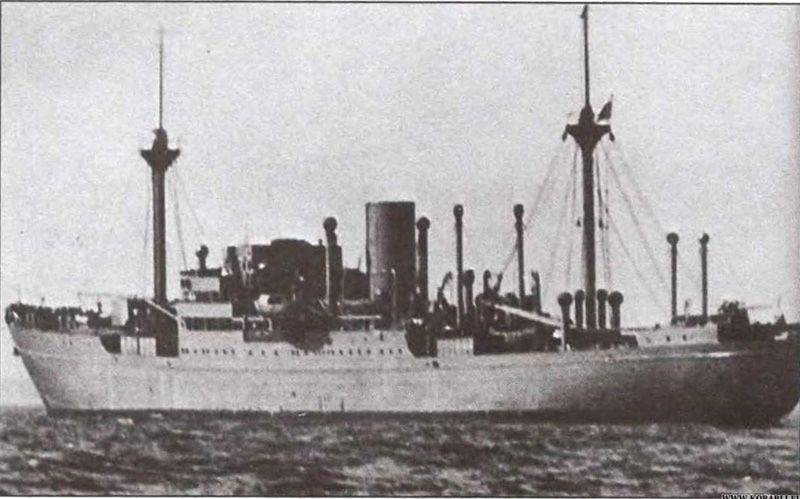
Trekking
When the pressure caused by going out to sea and forcing the Bay of Biscay, somewhat subsided, the crew began to retract on weekdays. Initially, it was not very easy: "Stir" was packed to capacity with various equipment and supplies. “It seemed to us that the ship was going to Antarctica,” the participant of the trip recalled. Corridors and decks were littered with bales, crates, sacks and barrels. Soon the raider reached the first area of action near Fernando de Noronha (archipelago northeast of the coast of Brazil).
4 June "Stir" opened his account. The first booty was the British ship Gemstone (5000 brt). Gerlach successfully entered from the side of the sun, and he was discovered only when he opened fire from the 5 distance of miles. The British did not resist - the team was transported to the raider, and the ship was torpedoed. As the interrogation of prisoners showed, the ship was transporting iron ore from Durban to Baltimore.
The morning of June 6 began with a rain squall, on the edge of which an unknown vessel was spotted. It turned out to be a Panamanian tanker, who immediately turned astern to the raider and opened fire with two guns. The chase began. "Stir" had to spend 148 shells of its "main" caliber and in addition to slaughter a torpedo in the stern tanker before the battle ended. “Stanwak Calcutta” (10 thousand. Grt) was in the ballast from Montevideo for cargo to Aruba. The captain and the radio operator officer along with the radio station were destroyed by the very first volley of the raider, so, fortunately for the Germans, the distress signal was not transmitted.
10 June held a rendezvous with the supply tanker "Carlotta Schliemann." Refueling was difficult: first, the Germans had to redo the fuel hose connections, then suddenly it turned out that because of the mistake of the senior engineer of the “supplier”, fuel containing more than 90% of sea water was pumped to the raider. Enraged Gerlach as a senior in rank gave the appropriate spacing.
In the meantime, bad weather has set in with storms and poor visibility. The commander "Stira" decides to request the headquarters permission to follow to the west coast of South America, where, in his opinion, there were more favorable "hunting" conditions. July 18 raider refills fuel with "Carlotta Schliemann", this time refueling passes normally. Not receiving anything good from the headquarters for redeployment, Gerlach is circling in a given area, not finding much needed loot. July 28 there was a rare meeting of two "hunters": "Stir" met with another auxiliary cruiser - "Michel". The commander of the latter, Rukshteshel, after consulting with Gerlach, decided to be together for some time in order to conduct the exercises of the personnel and exchange some reserves. Both German commanders considered the region northeast of the coast of Brazil unsuccessful for operating; shipping here, in their opinion, was extremely irregular. The joint voyage of the two ships took place until 9 in August, after which, wishing each other a “happy hunt”, the raiders broke up. "Michael" went to the Indian Ocean.
Just a few hours after parting with a craft colleague, a large vessel was observed, marching along a parallel course. Gerlach cautiously approached and fired a warning shot. To the surprise of the Germans, the "merchant" turned around and met them. At the same time, his radio station started working, transmitting a QQQ signal (warning of a meeting with an enemy raider). "Stir" began to work for defeat. The vessel responded with a small-caliber cannon, the shells of which did not reach the German ship. Only after the twentieth volley the Englishman stopped, having a strong fire in the stern. Dalhousie (displacement 7000 tons, went from Cape Town to La Plata in ballast) was finished off with a torpedo.
Alarmed by the alarm signal transmitted by the English ship, Gerlach decided to shift to the south - to the Cape Town - La Plata line. The commander of the raider, in addition, plans to make a stop near some remote island in order to make current repairs, to make preventive maintenance of the main power plant. The Germans refused to stop at the small volcanic island of Gough (the Tristan da Cunha archipelago), which was located at the beginning. The sea was hectic, and there was no suitable anchorage.
"Stir" frankly no luck with the search. The onboard seaplane Arado-231, originally intended for large submarines, scrambled and turned out to be unsuitable for flights. Several times the raider’s radio operators recorded powerful and close sources of radio signals. September 4 sentinel on the mast noticed a large ship sailing at high speed. The Germans identified it as the French Pasteur liner with a displacement of 35 thousand tons, under the control of the allies. The low speed (11-12 nodes) did not allow the Stir to rush in pursuit, and Gerlach only hoped that they were not recognized from the liner or would be mistaken for a harmless trader.
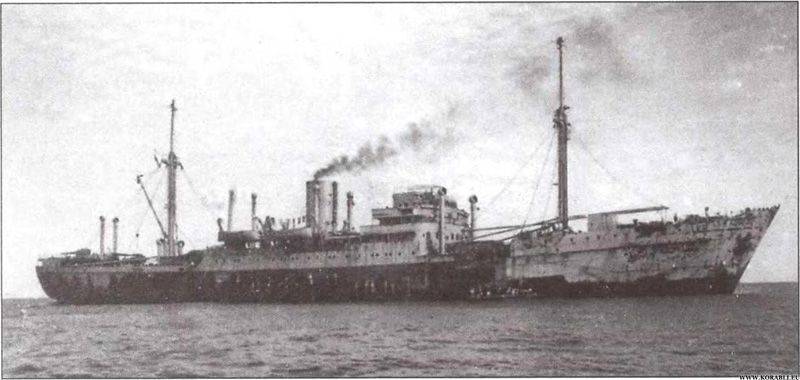
The fruitless search continued. Coal ran out of coal on the raider - it was needed for the operation of desalination plants. At least twenty tons per week. A radiogram came from headquarters informing that in early October the Stir was waiting for a meeting with the supply vessel Braque, from which fresh provisions, spare parts would be received, and, most importantly, the ammunition loss was compensated. In the near future, Gerlach was ordered to meet again with Michel, who was taking care of the Tannenfels blockade breaker, which was loaded with scarce raw materials from Japan to Bordeaux. September 23 near Suriname ships met. "Michel" soon disappeared again in the Atlantic, and the crew of the raider, taking advantage of the situation, decided to start painting the sides and minor repairs. Fortunately, in the German manuals it was stated that at the moment no vessels pass through this area. The instructions, as it turned out soon, were incorrect.
Battle and doom
On the morning of September 27, the Styra crew also carried out paint work. Tannenfels was nearby. A certain amount of provisions was overloaded from him to the raider, besides, the commander of the blockade "gave" a Japanese seaplane to Gerlach, which, however, was received without enthusiasm - there was no radio station and bomb racks on it.
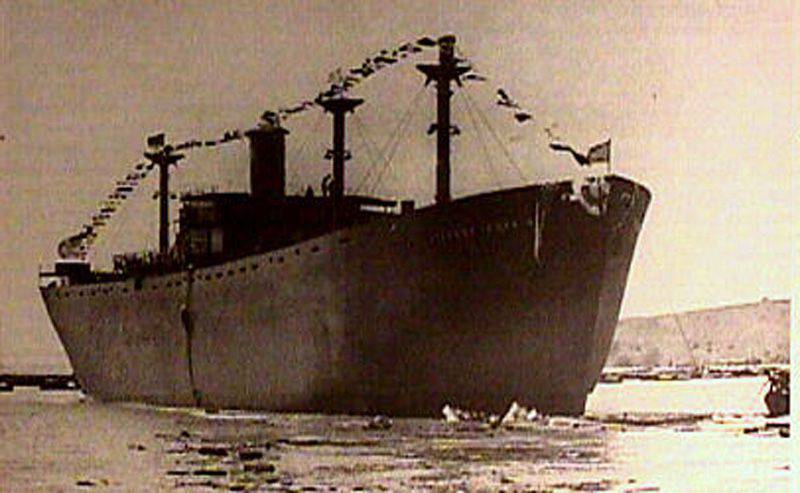
The sea was a light fog and drizzle. In 8.52, the mast shout shouted that he was seeing a large ship on the right side of the board. A “Stop or shoot” signal was immediately raised. On the "Stir" the bells of the loud battle rumbled - the alarm was declared. In 8.55, the calculations of main-caliber guns reported on their readiness to open fire. The ship ignored the signal and the German raider opened fire in 8.56. Four minutes later, the enemy responded. In this campaign, "Stir" just "lucky" for the "peaceful traders" is not a timid one. Subsequently, already in his report, the commander of the German ship would write that he had collided with a well-armed auxiliary cruiser, armed with at least four guns. In fact, the Stir met with the regular bulk cargo military ship of the Liberty type, Stephen Hopkins, armed with one 4-inch gun of the First World War period and two 37-mm anti-aircraft guns on the nose platform.
The Americans of the mid-20th century were people made somewhat different from the test than the current ones. The guys whose grandfathers mastered the Wild West, and the fathers built industrial America, still remembered what it means to be "free and courageous." Universal tolerance has not yet diluted the brains, and the American dream was still trying to sparkle with the chrome of the Ford radiator, whimper with the roar of the Liberators and the Mustangs, and not flicker on the TV screen with an ugly clown in the pink pantaloons of McDonald's.
"Stephen Hopkins" without hesitation took an unequal battle with the enemy ship, which at times surpassed it in the weight of the volley. Almost exactly a month before, 25 August 1942, in the distant Arctic, the old Soviet icebreaking ship Sibiryakov entered into a desperate and brave battle with the heavily armed battleship Admiral Scheer. It is unlikely that the Hopkins team knew about this - it was just doing its duty.
The American turned sharply to the left, and the "Stir", respectively, to the right, preventing the enemy from leaving. "Tannenfels" meanwhile jammed the radio station of the cargo ship. As soon as the raider turned around, he immediately received two direct hits. The first shell jammed the steering wheel in the extreme right position, so that the raider began to describe the circulation. The second hit was serious at all. A shell pierced the engine room and smashed one of the cylinders of a diesel engine. Splinters have caused other damage. Engine got up. However, inertia continued to move the "Stir", and he was able to enter into the battle of the left side guns. Gerlach tried to torpedo the Hopkins, but could not, because all the electrical equipment of the ship failed. German 150-mm guns fired heavily, despite the fact that the lifts did not work, and the shells had to get out of the hold manually. The American cargo ship was already burning hard and stopped. Apt hit the Germans destroyed his gun. By the way, the calculation of this unique, not even covered by an anti-splinter shield, gun was destroyed shortly after the start of the battle. The calculation numbers were taken by volunteer sailors, who were also mowed down by shrapnel. In the final minutes of the battle, the 18-year-old cadet Edwin OʼHara fired at the enemy alone until the gun was destroyed by an explosion. He was posthumously awarded the Naval Cross For Valor. The escort destroyer D-1944, which was commissioned in 354, will be named after him.
In 9.10, the Germans stopped firing for a few minutes: a rain squall divided the opponents. In 9.18, shooting resumed. Raider managed to achieve several more direct hits. The crippled enemies were drifting in sight of each other. The American cargo ship burned badly. Seeing the complete futility of further resistance, Captain Buck orders him to leave the ship. At about the 10 clock, "Stephen Hopkins" sank. Captain Paul Buck and the seriously wounded senior assistant Richard Mozhkovski, who refused to leave the ship, remained on board, as did the senior mechanic Rudi Rutz, who had not returned from the engine room.
The fight with his last victim cost dearly unsuccessful corsair. During the battle, "Stir" received 15 (according to other sources, 35 - the Americans beat from anti-aircraft guns) hits. One of the projectiles that exploded in the fore hold was interrupted by a pipeline connecting the propellant fuel tanks to the engine room. There was a fire raging that was less and less controlled. It was not possible to restore the full supply of electricity. Fire equipment did not function. Manual fire extinguishers went into action, but after a few minutes they were empty. The Germans lower boats and barrels behind the boat: they are filled with water and then lifted to the deck with great difficulty, manually. With the help of buckets and other improvised equipment, it was possible to stop the spread of fire towards the hold No. XXUMX, where the torpedoes were stored. The Kingstones, with the help of which it was possible to flood this hold, were inaccessible. The torpedo tubes were cut off by fire, but a torpedo officer with volunteers carried out a bold rescue operation and rescued people who were blocked in the interfacial space at the waterline level. Attempts to start with "Tannenfels" fire hoses were unsuccessful because of excitement.
The 10.14 was able to start the engines, but the steering still remained almost stationary. After another 10 minutes from the smoke-filled engine room, they reported that there was no way to maintain the operation of the power plant due to heavy smoke and rising temperatures. Soon the heat forced the sailors to retreat from the auxiliary steering post as well. The situation has become critical. Gerlach gathers his officers on the bridge for an emergency meeting, at which the condition of the ship at the moment was considered hopeless. The fire was already approaching the torpedo hold, and the Stir was directly threatened with the fate of the Cormoran, who, after a battle with the Australian cruiser Sydney, was destroyed by a fire and its own mines.
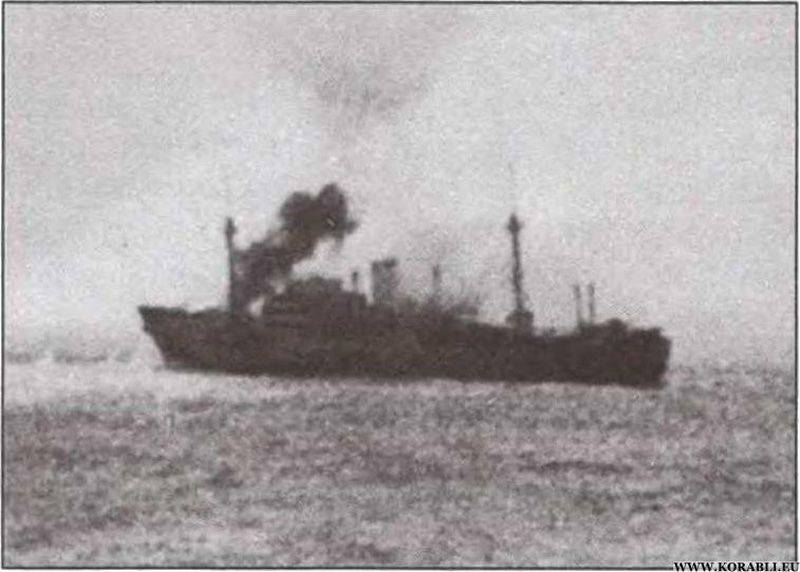
Given an order to leave the ship. Tannenfels receives orders to come as close as possible. Overboard boats and life rafts descend. To guarantee the Germans establish demolition charges. As soon as the blockade device finished picking people up, “Stir” exploded and sank in 11.40. During the battle, three Germans were killed, among them the ship's doctor Meyer Hamme. 33 crew member injured. Of the 56 people aboard Hopkins, 37 (along with the captain) died in battle, 19 survivors drifted for more than a month into the sea, having traveled almost 2 thousands of miles until they reached the coast of Brazil. Of these, four died on the way.
The German ship tried to find and pick up the Americans in hot pursuit, but poor visibility prevented this undertaking. 8 November 1942 of the Year Tannenfels arrived safely in Bordeaux.
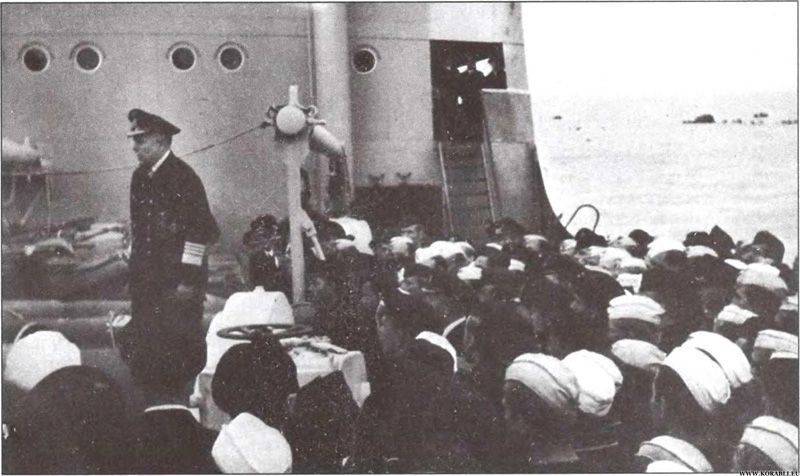
The end of the era of raiding
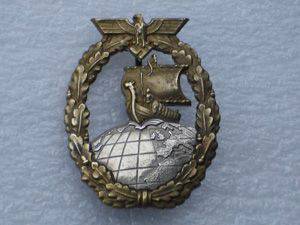
"Stier" was the last German raider, relatively safely out into the ocean. In October 1942, when trying to break into the Atlantic, the lucky “Comets” die before. In February 1943, the last petrel for Allied communications tears into the Togo ocean, but only to be badly damaged by the English Bofayters of the air patrol. After the failed New Year’s fight in the Arctic, Raeder leaves the post of commander fleet, and his post is taken by an adherent of uncompromising submarine warfare Karl Dönitz. Operations involving surface ships in the open ocean cease - all heavy ships are concentrated in the Norwegian fjords or used as training ships in the Baltic. Aviation and modern detection tools put an end to the era of auxiliary cruisers - trade fighters.
The fight on the sea completely passes into the hands of "grinning bearded men", submarine commanders. Gradually, the boat will become more and more, and bearded - less. Places in central positions and in the logging will occupy bezusy young men. But that's another story.
Information